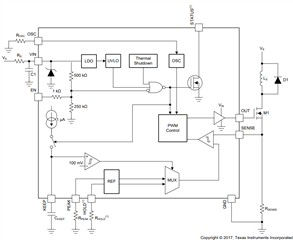Tool/software:
Hi all!
I'm working on a project design right now to drive a 1.5mH load at up to 13 A. I chose the DRV110 due to it being a hit/hold chip with adjustable current settings. I am using the SLIC024 calculation tool provided as part of the DRV110 product page (https://www.ti.com/tool/download/SLIC024) to change the current levels dynamically using a DAC, but I realized there is no such advice given on how to adjust the keep time. The datasheet and the calculator both show you can change the capacitance to change the time, but it doesn't seem like there is any way to change that value without changing the capacitor itself.
With the way the keep pin works (sourcing 1uA to a capacitor and switching Vref values when the keep pin reaches 100mV), we had the thought to try and include a variable current sink to draw a portion of the current away from the charging capacitor. We utilized a Widlar current mirror sourcing from a DAC output, but the MOSFETs being used had too much thermal instability (a small temperature swing would cause the charge time to jump drastically), and thermal stability is a requirement for the design. We also tried implementing an op-amp current sink (like the one seen here Programmable low-side current sink circuit (Rev. A)), and while that solved the thermal issues, it introduced its own forms of instability.
Are there any suggestions on how we might be able to adjust the keep time dynamically? Ideally it could be controllable via a DAC output, similar to how the hit and hold currents can be set with a DAC output. If there is no method of changing the keep time, are there any other driver chips that might have this functionality?


